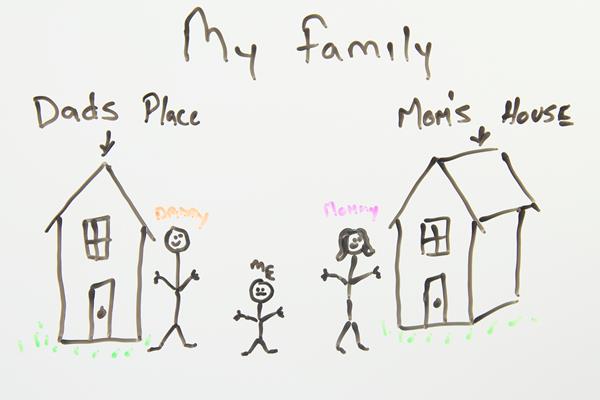- Home
- Co-Parenting
- Living in Two Homes
Living In Two Homes After Divorce
One of the most difficult changes for children in divorced families to adjust to is living in two homes. You can make it easier on your kids by working with your ex to ensure they feel at home with both of you. Things like having similar rules and making sure your child has their own space will help make the transition a lot smoother. Keep reading to learn more tips on helping your children adjust to their new living arrangements.
Two Homes to Live in - Helping Children Adjust to Joint Custody
By Donna Ferber

One of the most challenging adjustments for children in a divorced family is living in two homes. Even if a child only visits one parent for a few hours a week, the child should feel at home in the non-custodial home.
This helps foster connection with the non-custodial parent and helps the child to recognize that the non-custodial parent didn't "divorce" him/her. Issues of abandonment and rejection are paramount for children of all ages, although the young ones can't express it and the older ones won't.
Creating a sense of belonging in both homes assists the child in making a healthy transition. Many children actually enjoy having two homes because they get special attention, and often have two birthday parties and two sets of Christmas or Chanukah gifts.
Here are some ways to help children adjust to living in two homes
- Even if the children split their time, it is helpful for them to think of one home as the "primary home" Consider this, even if you have a summer house or ski chalet, it helps to think of one home as the "main residence" All your mail and legal paper work goes to that address, which cuts down on confusion. It also helps children feel anchored and secure. If your house is considered the secondary home don't think of the time with you as less important. You would love being at your vacation home as much as your main house!
- The child should have her "own room". If this isn't possible, she should have her own space in a room - her own dresser drawer, a toy bin, or even just shelf space that is uniquely hers.
He should be allowed to keep his things in that space and arrange them as he wants to. - Let the child help decorate the space. By picking out her own sheets or a poster to hang on the wall, she personalizes the space.
- She should have clothes in both homes.
- He should be allowed to carry his things back and forth between two houses without parental tension or conflict. This helps with the transition.
- Parents should cooperate in returning clothes and toys.
- Pick up and drop off should always be cordial, on time and upbeat. Save your hostility for court.
- Follow the visitation schedule even when the child feels sick. This reinforces both parents' ability to care for the child. It helps the child feel he is safe with both parents and part of a household. When we only send children when they are healthy, the message is that one parent is really the "reliable one." It undermines the other parent and creates a "Disneyland Dad (or Mom)."
- Rules and consequences should exist in both homes. Many non-custodial parents are afraid they will "ruin" visitation if they discipline the child. Parenting involves both discipline and respect. If you don't want to feel like an outsider in your child's life, then don't act like one.
- If possible, rules in both homes should be similar. However, even if they differ it is not a problem as long as the rules remain consistent in each home. Children learn at a very early age that there are different rules in different places - school, camp, church, grandma's house. They can handle another difference, as long as the rules are reliable and consistent in each environment.
- The child should be allowed to call the other parent, but should not be made to do so.
- Recognize the child needs "transition time" Allow some quiet time before the child transitions to the other home.
- For young children, record yourself reading some of their favorite bedtime stories. When they are away they can listen to the CD at bedtime. This helps them feel more secure and connected.
- Imagine you are going on vacation or traveling for business. Even if it is a pleasurable change, traveling still involves some anxiety. While living in two homes can be very enjoyable, be mindful and considerate of the adjustment the child needs to make with each transition.
Think about ways to make the transition easier for my child. Consider showing this article to your child's other parent as a way to open a dialogue on how to make this happen. Put aside all hurt and angry feelings about the marriage and deal with spouse as your child's parent, knowing that when our child has a good relationship with both of us, then he/she will thrive. (*author's note - I switch gender throughout the piece to avoid the use of awkward "him/her" language)
© Donna F. Ferber - all rights reserved. Donna Ferber is a Psychotherapist, author, and speaker.
For more tips to help ease the adjustments of living in two homes, check out the following articles:
